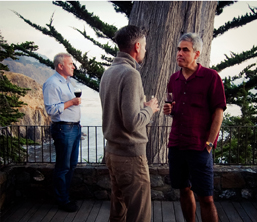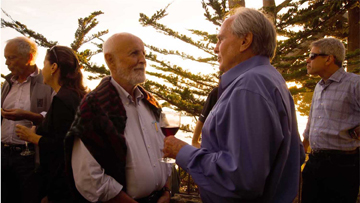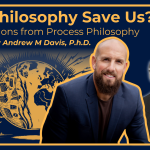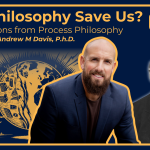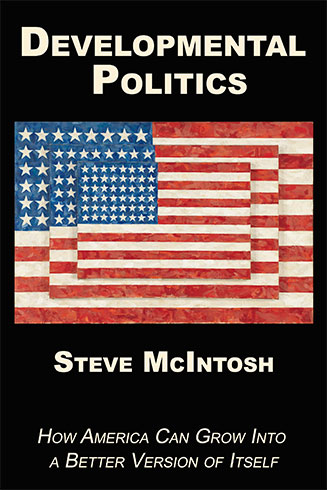Reflections on Esalen’s 2014 Conclave on Political Polarization
This past week I was at The Esalen Center for Theory and Research on California’s legendary Big Sur coast. I came to Esalen to participate in an event I’ve been helping to plan for close to a year: The Conclave on Political Polarization. Since December 2013, The Institute for Cultural Evolution (“ICE”) has been working with Esalen’s Chairman Sam Yau and fellow board member Jay Ogilvy to bring together a group of twenty-five distinguished public figures, political scientists, pundits, insiders and activists to discuss how to ameliorate the hyper-partisanship that has now made America’s democracy dysfunctional. ICE co-hosted this gathering as part of our larger campaign to help “depolarize the American electorate,” as detailed on our website.
In planning the Esalen Conclave we did our best to assemble a diverse group from across the political spectrum, but most of those who came were centrists or center-left. This was predictable, however, as these are the folks who are most concerned about the problem. The gathering did include seven self-identified Republicans, but they were fairly centrist themselves. Nevertheless, we managed to uncover some interesting differences of opinion, together with a variety of promising proposals for ameliorating the problem, which I describe in this brief article.
Interesting Differences Regarding the Primary Causes of Polarization
Although there seemed to be clear agreement among the group that our democracy’s currently dysfunctional condition is something we need to get beyond, clear differences of opinion emerged regarding whether the polarization is actually representative of the electorate, or artificially manufactured by the two major parties. This latter view holds that ideological polarization in the electorate is actually a myth and that Americans have been merely “sorted” by hyper-partisans on both sides. This argument has been advanced by Stanford political scientist Morris Fiorina, and has been particularly influential among centrists who would like to believe that Americans are not really divided deep down. For those who agree with Fiorina’s thesis, straightforward structural solutions such as depoliticizing congressional redistricting and reform of party primaries seem best, especially when these reforms are linked with process solutions, such as those which seek to bring more civility to political dialogue.
At the Esalen gathering, those who accept Fiorina’s arguments and find hope in the fast-growing group of Americans who register as “independent” included John Avlon, Editor of the Daily Beast, and “Transpartisan” activists Mark Gerzon and Lawrence Chickering. However, the “sorted not polarized” advocates were challenged at the Conclave by the research of distinguished political scientists Thomas Mann and Norman Ornstein, who see the polarization as partially reflective of real differences in ideology. According to Mann and Ornstein these differences have been produced largely by a significant rightward swing by Republicans since the 1990s. The idea that the electorate itself is polarized was also driven home by the data presented by political scientist Alan Abramowitz, who argued against Fiorina’s thesis. Abramowitz pointed out that almost all independents lean strongly to one side or the other, and most registered independents are actually more partisan than the less committed members of the party they lean toward.
Notably, these mainstream liberal political scientists found allies at the gathering among those who bring an “evolutionary perspective” to the problem. This evolutionary or developmental view sees polarization as resulting from the natural outworking of cultural change, and accordingly calls for fostering further cultural evolution as the best solution. In addition to myself and ICE colleague Carter Phipps, this developmental perspective was also held by Esalen’s esteemed founder Michael Murphy, and fellow board member Jay Ogilvy. And somewhat surprisingly, Republican activist and Washington insider Rich Tafel also held this evolutionary view. After finding so much common ground with Rich at the Conclave, I felt as though I was encountering a long-lost brother (even though I’m a registered Democrat).
Interesting Proposals for Ameliorating Political Polarization
Among the many prominent attendees, influential social psychologist and best-selling author Jonathan Haidt made perhaps the biggest impression by focusing on the values of Left and Right. Haidt recommended overcoming polarization by building agreement that our democratic institutions are actually sacred. He called this strategy “moralizing democracy,” and contrasted it with the purely pragmatic approach taken by mainstream bipartisan organizations such as No-Labels.
I appreciated and agreed with Haidt’s proposal, but expressed concerns that the implicit endorsement of patriotic nationalism was “cringeworthy” for many on the Left. While ICE’s vision of a more evolved Future Left (discussed below) includes a place for healthy patriotism, the value of “freedom” may be easier to sanctify than democracy, as it is freedom that the Chinese and most Islamic countries still lack.
Another interesting proposal came from Republican Rich Tafel, who together with Andrew Sullivan started the push for gay marriage in the 1980s. Tafel argued that the best way to make political progress is to find ways to get the other side to champion the issues you care about. For example, the movement for marriage equality actually originated on the Right. Despite the objections of social conservatives, the issue of gay marriage evoked central Republican values, such as individual liberty and the importance of family. Although it eventually became championed primarily by the Left, the dramatic success of gay marriage over the past few years can be partially attributed to the way it affirms values that most conservatives support. After listening to Tafel, I saw how this strategy might be used to advance the fight against climate change, as the emerging opportunity to build a new energy economy appeals to Republican sensibilities by benefiting American business and encouraging entrepreneurial innovation.
At the end of the second day Carter Phipps and I presented ICE’s campaign to “Depolarize the American Mind,” which calls for a national conversation to help develop and refine “Future Left” and “Future Right” positions that carry forward the core values of each side while better integrating the strengths of the opposition.
This strategy accordingly seeks to diminish polarization by increasing the scope of what people are able to value. Our ideas were warmly received by a number of Conclave participants, including Thomas Mann, and the dynamic duo of Shellenberger and Nordhaus, founders of The Breakthrough Institute think tank.
Back in 2011, when we first conceived of founding the ICE think tank, my colleagues and I looked to The Breakthrough Institute as an inspirational model of what we could become. Yet before the Esalen Conclave we had never met Michael Shellenberger or Ted Nordhaus, and were not sure whether they would view us as allies or rivals. But after our presentation we ended up laughing with them till past midnight, drinking wine on the deck overlooking the crashing waves. It seems like part of the magic of a conference at Esalen is the way the beautiful surroundings help create new friendships. And we made many new friends indeed at the Conclave. It is thus my hope that this emerging network of those who care deeply about the success of our democracy may eventually blossom into a politically effective fellowship of activists.
The success of this year’s conclave has motivated the leaders of both Esalen and ICE to make this at least a three-year project, with two more gatherings planned: one for next year and another just before the 2016 Presidential election. And with luck, this growing fellowship may make a meaningful contribution to America’s further political progress.




